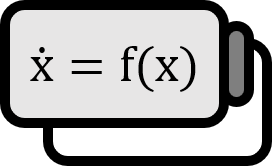Attractors in Chaos
Definition 1
Let the space be $X = \left( \mathbb{R}^{n} , \left\| \cdot \right\| \right)$ and a smooth function $f,g : X \to X$. Consider that a vector field and map are expressed as follows:
$$
\dot{x} = f(x)
\\ x \mapsto g(x)
$$
Let $\phi (t, \cdot)$ be the flow of the vector field $\dot{x} = f(x)$, $g^{n}$ be the $g$-th iterate of a map, and $\Lambda \subset X$ be a compact set that is invariant under either $\phi (t, \cdot)$ or $g(\cdot)$. We say $\Lambda$ is chaotic if it satisfies the following two conditions:
- (i): $\phi (t,x)$ or $g(x)$ is sensitive to initial conditions on $\Lambda$.
- (ii): $\phi (t,x)$ or $g(x)$ is topologically transitive on $\Lambda$.
Some literature includes a third condition as follows:
- (iii): The periodic orbits of $\phi (t,x)$ or $g(x)$ are dense in $\Lambda$.
Explanation
Intuitive Explanation
In chaos theory, a chaotic attractor is a concept that is important and intriguing enough to give the field its name. However, it can be challenging to grasp this concept intuitively as it has become deeply mathematical and theoretical. Consider the following GIF:

This GIF illustrates the trajectory of the Lorenz attractor. Initially, it seems to enlarge and rotate only on the left side, but eventually, it randomly oscillates between left and right without a predictable pattern, never re-crossing the same point or drifting away to a distant place. This behavior is a representative example of chaos in the dynamical systems of interest.
The fact that this does not exhibit periodic orbits means that while the point in space appears to loop around similar areas, it never returns to a previously visited point. The ‘butterfly-shaped trajectory’ drawn by this point is the strange attractor.
Mathematical Explanation
Without the compactness condition, many counterexamples arise that meet the conditions but have predictable futures. As a naive example, consider a system $\dot{x} = ax$ for $a>0$; the solution $\phi (t,x) = e^{at} x$ can be sensitive to initial conditions. However, calling this diverging infinitely far away into the unknown “chaos” seems unjustified.
- (i): Since dynamical systems are deterministic, saying they are sensitive to initial conditions implies ‘uncertainty’ about the future. For non-specialists, chaos theory often conjures the notion of the ‘butterfly effect,’ explicitly and unexaggeratedly expressed in the phrase ‘a butterfly’s wings might cause a storm on the opposite side of the earth’.
- (ii): Being topologically transitive means, in simple terms, that any point in $\Lambda$ can be accessed from any region within $\Lambda$, courtesy of the system. Without this condition, even a well-ordered system that converges or diverges at a single point according to consistent flow would have to be deemed chaotic.
- (iii): Some authors choose not to include this condition. It may seem strange that perspectives on chaos can differ, but this emphasizes how difficult it is to describe the essence of chaos in words. While ‘periodic orbits’ might not initially seem chaotic, given the adherence to the first two conditions, this isn’t guaranteed. Denseness of the orbit in $\Lambda$ implies that—at least within $\Lambda$—there should be no ‘gaps,’ vigorously exploring every nook and cranny. Conversely, exceptions can be excluded within $\Lambda$ by removing fixed points to satisfy this condition.
See Also
Wiggins. (2003). Introduction to Applied Nonlinear Dynamical Systems and Chaos Second Edition(2nd Edition): p737. ↩︎
